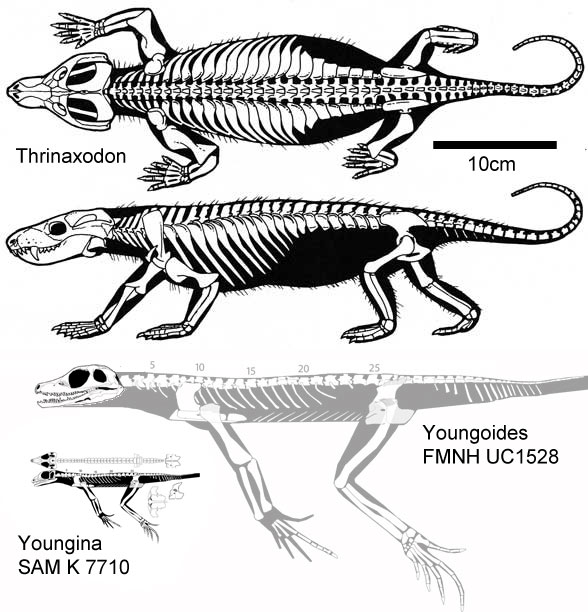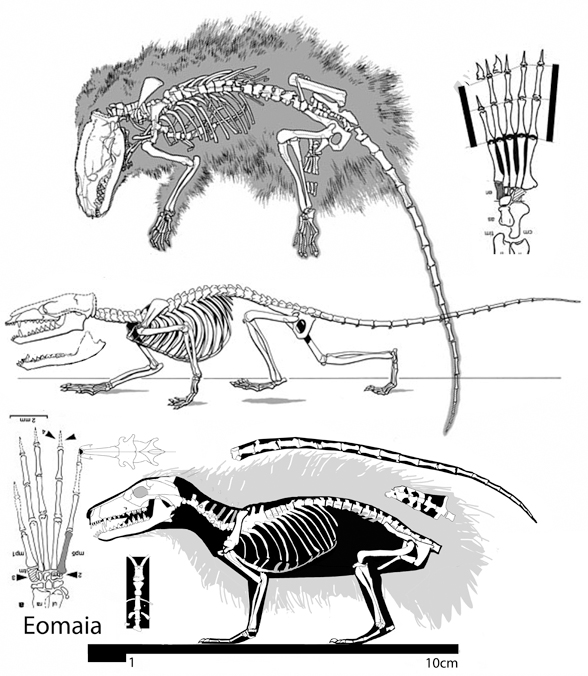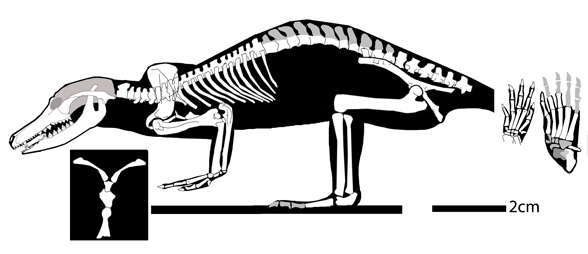Here’s a new video (50 minutes)
on several of the first mammals and their cynodont ancestors featuring animated taxa and the work of paleontologists who study them with microscopes and synchrotrons.
The producers of the video
gave burrowing Thrinaxodon (Fig 1) a thick, short, coat of fur. That’s probably a little too soon. Sparse hair, like the naked mole rat, Heterocephalus, was probably more appropriate based on phylogeny and a tunneling ecology. The producers also gave Thrinaxodon erect limbs. Again, this is too soon, based on the still-sprawling forelimbs. A monotreme like Ornithorhynchus, is a better model, swinging its lumbars from side-to-side.

Figure 1. Thrinaxodon, a burrowing synapsid from the Early Triassic was similar in size and proportion to the Late Permian ancestor of all archosauriformes, Youngoides (Fig. 2). These similar basal taxa were the genesis for all later mammals, dinosaurs and birds. From 2016.
Early Cretaceous mouse-sized
Eomaia scansoria (Fig 2) was described as the ancestor of placental mammals. In the LRT Eomaia is a smaller ancestor to Didelphis, the Virginia opossum. A closer ancestor to placental mammals is the pouch-less extant Monodelphis (Fig 3).
The producers gave Eomaia closely cropped hair and a bushy tail when fossils preserved a broader pelage, like an opossum, with a naked tail.
The producers also show Eomaia bringing back an insect to the waiting babies. By contrast, phylogenetic bracketing would have the youngsters in a pouch feeding from the nipples (Fig 3) or just hitching a ride on an overburdened mother.

Figure 2. Eomaia holotype exposed in dorsal view and reconstructed as originally published and revised here.
The specimen shown
@21:10 exposed in ventral view is not the holotype of Eomaia, which is slowly exposed in dorsal view (Fig 2). Perhaps this is a second unpublished specimen.

Figure 3. Monodelphis mother with her growing brood of young clinging to her fur and nipples.
Early Cretaceous 1m long
Repenomamus giganticus (Fig 4), featured next, is not a mammal, but a late-surviving cynodont in the LRT. Again, they gave Repenomamus a gallop with a dorsally curved back, rather than a laterally sinuous spine, like a monotreme.

Figure 5. Repenomamus giganticus reconstructed.
Middle to Late Jurassic
Volaticotherium (Fig 6) is featured next. Very little time was given to this taxon, perhaps because it left no known descendants.

Figure 6. A new reconstruction of the skull of Volaticotherium along with the skull of Morganucodon to scale. Note the odd molars. No descendants are known yet.
Then the video takes a turn into genomics
when they feature Dr Olaf Bininda-Emonds, U of Oldeburg who published on mammal genes in 2007. This worker was featured in a 2018 video, ‘The Dawn of Mammals’ (no longer available) discussing genomics vs phenomics following the asteroid impact.
Bininda-Emonds et al 2007 reported,
“Our analyses of how extant lineages accumulated through time show that net per-lineage diversification rates barely changed across the Cretaceous/Tertiary boundary. Instead, these rates spiked significantly with the origins of the currently recognized placental superorders and orders approximately 93 million years ago, before falling and remaining low until accelerating again throughout the Eocene and Oligocene epochs.”
They also reported,
“Our results… challenge the hypothesis that the end-Cretaceous mass extinction event had a major, direct influence on the diversification of today’s mammals.”
That matches LRT results among arboreal taxa only.
There were zero comments on this 2007 Nature paper.
Challenging this report,
Dr John Wible said (as he said in the 2018 video,“Our study supported the traditional view that there were no fossils living during the Cretaceous that were members of the placental group itself. There were only ancestors of the placentals living.”
Wible does not understand that several placentals are known from the Cretaceous and Jurassic in the LRT, typically within the multituberculates, members of the clade Glires.
Earliest Cretaceous
Zhangheotherium (Fig 7) is featured next. In the LRT it is a pre-mammal cyndont.

Figure 7. Zhangheotherium reconstructed. The tail is unknown. The high scapulae indicate great strength in the pectoral region, likely for arboreal locomotion in a taxon of this size. Zhangheotherium nests as a basal pangolin. It was preserved in ventral view. Here the epipubes are identified as pubes, which is otherwise not shown.
Late Jurassic
Juramaia (Fig 8) concludes this video. The workers considered this the oldest placental.
After testing in the LRT, Juramaia is a monotreme, an egg-laying mammal.
References
Bininda-Emonds ORP et al (9 co-authors) 2007. The delayed rise of present-day mammals. Nature 446:507–512.
‘The Dawn of Mammals’ YouTube video illuminates systematic problems
